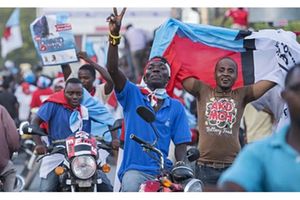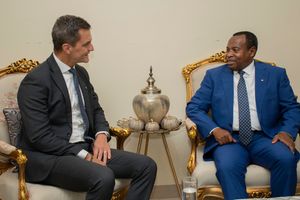The Mau Mau general who stopped Idi Amin in his tracks

What you need to know:
- In Kenyan military barracks, soldiers were packing their gear in preparation for war. The time had come for them to defend their country. But, arguably, the news hit one particular man harder than many others. His name was Waruhiu Itote, also known as General China.
One morning in 1972, the big man next door had a revelation that seemed too brilliant to pass up.
In his wisdom, the Ugandan dictator Idi Amin Dada decided that his country’s eastern borders extended all the way to Naivasha. And he was prepared to go to war over it to reclaim his country’s territory.
In Kenyan military barracks, soldiers were packing their gear in preparation for war. The time had come for them to defend their country. But, arguably, the news hit one particular man harder than many others. His name was Waruhiu Itote, also known as General China.
“He couldn’t believe that anyone in his right mind would be courageous enough to attack Kenya after the kind of war they had waged against the mzungu. He was furious,” recalls his widow, Margaret Waruhiu.
Liberation war
With memories of a liberation war still fresh on his mind he, along with the top command of the National Youth Service, rushed to State House Nakuru to hear what President Jomo Kenyatta thought of Amin’s war talk.
“It is said that while at State House, he asked Kenyatta for permission to lead troops into Uganda and end the threat of war once and for all. He told Mzee that he would bring back Amin’s head as a gift,” Mrs Waruhiu told Lifestyle.
Legend has it that Amin, who had spent time fighting alongside General China in World War II, ceased any talk of extending his country’s borders when reports of the Nakuru meeting reached Kampala.
“He was that kind of a man. Fearless,” his widow says.
General China acquired his legendary status fighting the colonialists out of the Mt Kenya and Aberdares forests, alongside other famed freedom fighters such as Field Marshal Dedan Kimathi, Field Marshal Musa Mwariama and General Stanley Mathenge.
In the battles against the British, the General escaped by the skin of his teeth after he was hit by a bullet. That was 1954. He healed from the wounds, was later released from custody by his captors and lived to tell the tale with the bullet still lodged in his body for over 34 years.
Kenyan history
Seventeen years after the general’s death, a bullet that had been a part of him is on its way to being immortalised on one of the pages of Kenyan history.
In 2010, Mrs Waruhiu and her stepdaughter Mary were at the National Museums of Kenya to donate the bullet that was lodged at the base of General China’s neck for three decades. Its exhibition was one of a series of events planned by the museum to celebrate its centenary.
Accoridng to Prof Peter Odhiambo, who surgically removed the bullet in 1988, it had gone through his chin, bruised his collarbone, ricocheted to the left then lodged itself at the base of his neck.
But on the day of the surgery, Prof Odhiambo recalls that the stoic general was more than worried. He had had a number of near-death experiences as a freedom fighter and fighting for the British in far-flung places as Ceylon and Burma before that.
This time, however, it was different. There were no comrades to cover him from enemy fire and he was going into the battle unarmed. He would be at the mercy of the surgeon’s knife.
“He was worried. He expressed fear that he might not walk out of the operating room,” says Mary. At the time of the procedure, the general was 66.
“He was afraid his body wouldn’t recover from the effects of the surgery but we understood. He was a soldier. It wasn’t easy for him to trust anyone with his life,” Prof Odhiambo says.
His daughter adds that was the first time she saw worry on her father’s face as he was wheeled into the operating room.
Meanwhile, his wife Margaret, was somewhere on the Kenyatta National Hospital grounds praying for her husband to conquer the latest battle of his life. He survived a nine-hour surgery on March 24, 1988.
“We were confident that the surgery would be without complications. That is why, in spite of the fact that he had lived with the bullet for decades with no pain, we insisted on removing it because there was always the possibility of it posing a health risk in his final years,” said the professor.
The former Mau Mau veteran did not know that he had it within him for years since he had been convinced the bullet had exited his body.
Mau Mau in Action, a book he wrote chronicles the events that led to the attack. It was also one of the last missions he undertook as a freedom fighter.
The book says that at the beginning of the freedom struggle, the fighters set out to form a committee to take up armed resistance against the colonialists.
The committee, aptly named the War Council was formed in 1952 with a strictly guarded membership. It was composed of young men ready to die for their country.
“Despite the fact that the older members were against any form of bloodshed many more were convinced that independence could never be won through peaceful means. It is them who joined the War Council,” said Mrs Waruhiu.
To properly carry out their purpose, the council was forced to steal arms from government reserves. As an incentive, cash rewards were offered to members depending on the type and size of weapons they brought in.
On January 15, 1954, General China, together with six other Mau Mau fighters, took part in an operation to obtain guns from a police post in Mathira. But luck was not on their side that particular day. They were spotted and surrounded by government forces.
Shot in the head
“Suddenly we heard gunshots and when we went to find out what was going on, I was shot. I thought the bullet had gone through me. One of the stretcher-bearers was shot in the head. I was abandoned to be arrested later by colonial forces,” General China told the Daily Nation in a past interview.
He was charged with consorting with persons carrying firearms and being in possession of two rounds of ammunition, found guilty on all counts and sentenced to death. His term was later changed to an indefinite sentence.
After cheating death many times, the general died in 1993 leaving memoirs of his years in the liberation war so that future generations can have a bit of history passed down from their forefathers.
Although he was ready to share a part of their liberation struggle, some secrets, like the origin of his name, accompanied him to his grave.
“We suspect that he took up an alias like several of his colleagues to mask his true identity,” says Mrs Waruhui.
The oath he took as a Mau Mau fighter didn’t allow him to reveal any details about the organisation, even to close family members.
It is hoped that the bullet – and several other personal items, including a brown leather coat, a leather bag and a cap, that belonged to the general – have found a place in the annals history.
“This was his dying wish. He made us promise to donate anything that would help Kenyans understand their history better. Nothing illustrates the liberation struggle more than the bullet he carried around for all these years,” said a teary Mary as handed in the bullet, slightly longer than an inch, at the museum.
Excuse for laziness
Before joining the freedom struggle, the general had several attempts at education and business. He was born in 1922 and is said to have attended school against the wishes of his father, who regarded education as an excuse for laziness.
This led to altercation between him and his father, and in 1939, aged 17, he left home for Nairobi, ostensibly to chart a new path for his life and escape his father’s beatings.
After working briefly in several factories he, together with several friends, started a vegetable business. It is during this time that he married his first wife Leah Wambura in December 1940. The following year they closed down the vegetable business.
In 1942 he was drafted into the World War II as part of the KAR (King’s African Rifles) contingent. He served in Tanganyika, Burma and later in Uganda.
After the war, he passed up an opportunity for promotion and asked to be discharged. He immediately went into charcoal burning.
When the charcoal business went bust, he proceeded to work as a fireman for the East African Railways and Harbours Administration till 1951. By this time, he was actively involved in politics and particularly the Kenya African Union (KAU).
He also became a member of another clandestine movement called The Forty Group that mainly comprised former KAR servicemen.
Be combat-ready
Eventually, he was recruited into the Mau Mau and, in 1952, assigned to train 40 young men to be combat-ready. They proceeded to their base in Mt Kenya forest. That is where he was shot and subsequently arrested.
He was released in 1962 after doing time in various detention camps around the country. Later on that year, he left for military training in Israel.
Upon finishing his course in Israel, he returned to Kenya and served as an assistant director of the National Youth Service under former Starehe Boys Centre director, Geoffrey Griffin. He held the position for two decades up to1984.
At the time of his death on April 30 1993, he was in business and farming.
“Wherever he may be, we are sure he is happy to have been a part of Kenya’s history,” his widow concludes.




